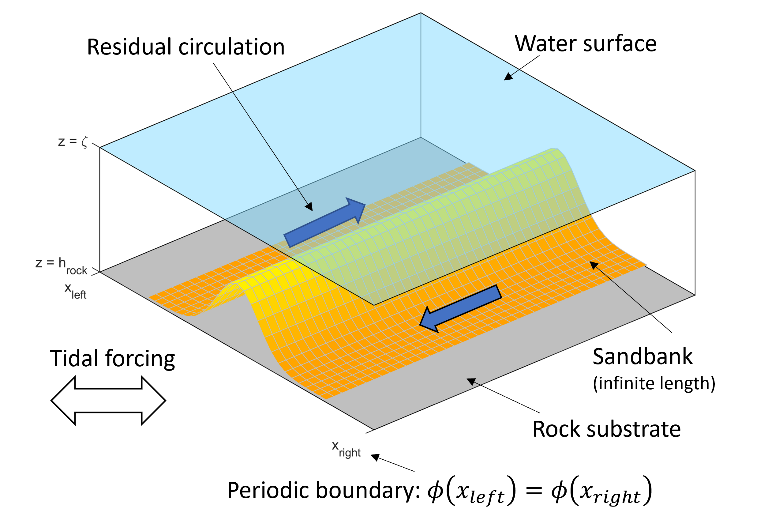T.J. van Veelen1,2*, P.C. Roos1, S.M.J.H. Hulscher1
1 University of Twente
2 Swansea University
*corresponding author: This email address is being protected from spambots. You need JavaScript enabled to view it.
Introduction
Tidal sandbanks are large-scale marine bedforms observed at the bottom of shallow seas such as the North Sea and the Irish Sea. They are large-scale rhythmic bottom features with lengths of tens of kilometres, widths of kilometres, and heights of tens of metres (de Swart & Yuan, 2019). Due to their large size, they are of interest for marine ecosystems, and economic activities like wind farms and sand extraction. Process-based models have explained their growth as a free instability of the flat bed (Hulscher et al., 1993), and have shown that sandbanks may evolve towards an equilibrium under unrestricted sediment supply (Roos et al., 2004). Our understanding may not apply to areas with a non-erodible substrate, such as sandbanks on the Belgian Continental Shelf. It is not yet known how the non-erodible layers affect the morphodynamic evolution of the sandbanks, their equilibrium height and shapes as well as their capacity to recover from sand mining. Therefore, we introduce a non-erodible layer in a process-based model to understand how it affects sandbank evolution.
Methods
We have introduced an entrainment limiter in the modelling framework by Roos et al. (2004) to simulate the impact of non-erodible layer. Our model includes nonlinear hydrodynamics, sediment pick-up and deposition, and stirring of sediment by wind waves. The topography (Fig. 1) varies in one dimension only. The entrainment limiter is applied to the sediment pick-up function in areas where the hard layer is exposed or nearly exposed. The limiter decreases gradually within a buffer layer such that the sediment pickup function is continuous and numerical stability is improved.

Figure 1: Model domain including sandbank topography. The yellow-orange bank represents the 1-D sandbank topography. The grey plane represents the non-erodible substrate.
Results
Our focus lies initially with the evolution of the cross-sectional shape h(x) and its equilibrium profile heq(x). The crest height is limited by the presence of a non-erodible layer. Furthermore, its ability to recover from sand extraction may be reduced. Our results give insight in the dynamics of sandbanks on non-erodible layers, thus supporting sand extraction strategies in areas where sand supply is limited.
References
de Swart., H.E. & Yuan B. (2019) Dynamics of offshore tidal sand ridges, a review. Env. Fluid Mech., 19(5), 1047-1071. doi: 10.1007/s10652-018-9630-8
Roos P.C., Hulscher S.J.M.H., Knaapen, M.A.F., Van Damme, R.M.J. (2004) The cross-sectional shape of tidal sandbanks: Modeling and observations. JGR Earth Surf., 109 (F2). doi: 10.1029/2003JF000070
Hulscher S.J.M.H., de Swart, H.E., de Vriend,H.J. (1993) The generation of offshore tidal sand banks and sand waves. Cont. Shelf Res., 13 (11), 1183-1204. doi: 10.1016/0278-4343(93)90048-3










